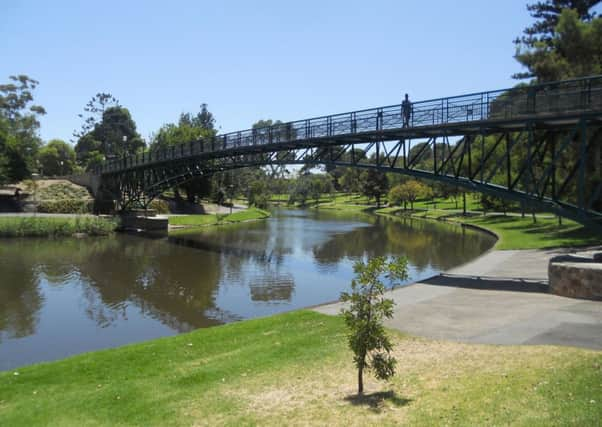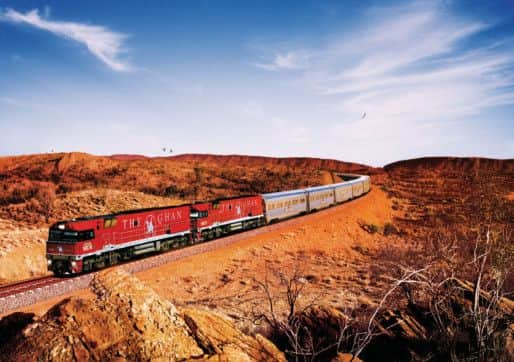Australia: Outback story


The fiery orange sun slowly sank into the hazy horizon as former Deputy Prime Minister Tim Fischer introduced singer-songwriter James Reyne on stage for a special acoustic set. However, it wasn’t the popular ex-politician, the platinum-selling Australian Crawl musician, or even the spectacular fireworks put on by those responsible for the New Year’s display at Sydney Opera House, that the residents of Pimba (population 50) had gathered to see.
No, the main star of the show on this hot, dusty evening in the middle of the Aussie Outback was a train.
Advertisement
Hide AdAdvertisement
Hide AdIt’s 10 years since The Ghan made its maiden cross-continental journey all the way from the bottom of South Australia to the top of the Northern Territory, and the original staff, drivers and passengers from a decade ago, along with other lucky newcomers like me, were celebrating the milestone as part of a commemorative ‘Ghanniversary’ trip.


What makes The Ghan so unique and special is its backstory. Its moniker is an abbreviated version of its previous nickname The Afghan Express, and honours the camel drivers who arrived in Australia during the late 19th-century to help find a way to traverse the country’s vast unexplored interior. Back in 1929, the very first Ghan departed Adelaide bound for the town of Stuart (now Alice Springs). It was always intended that the line would eventually be extended all the way to Darwin, the service becoming transcontinental. Following decades of wrangling and deliberation, The Ghan left Adelaide on February 1, 2004, bound for Darwin. Its arrival in the city signified a new era of tourism in the Northern Territory, making travel easier as well as providing better access for Aboriginal communities in the region. On the Ghan, there are three choices of accommodation, including the Red seats, which are pretty typical of first-class areas on UK trains.
However, to get a true taste of the train’s magnificence, you need to stay in the Gold or Platinum cabins which offer pull-out beds, wardrobe space and a safe, plus as much food and drink you can get down you. During my three days on board, I eat like a king (or at least like a pop star or former Deputy Prime Minister), tucking into full Australian breakfasts (with Vegemite on toast, of course) and a variety of grilled delicacies, including saltwater barramundi, emu and kangaroo for lunch and dinner. In between the eating, drinking and resting, the hours whizz by.
With an intermittent phone signal and no TV, radio or internet on board, it feels like I’m in my own peaceful little bubble. I find myself hypnotically staring out of the window for minutes, sometimes hours, on end, as the scenery changes from the parched farmlands of South Australia, past rivers and ocean, to the notoriously harsh red centre and termite mound-littered Outback, before arriving in Crocodile Dundee land – the bush and swamps of the Northern Territory.
Advertisement
Hide AdAdvertisement
Hide AdI also play frequent games of animal-spotting with other passengers – I clock a court of kangaroos and flock of emus, while my companions pick out water buffalo and crocodiles. After our stop off in Pimba, we arrive in Alice Springs the next morning. A fun way to spend a few hours just outside Alice is at Pyndan Camel Tracks.
My guided camel ride around the farm gives me a small taste of how life must have been for the Afghan drivers who made the journey through Australia’s harsh interior.
Then it’s on to Katherine the following day, where guests can take a tour of the town to sample the local indigenous population’s culture – didgeridoo playing, kangaroo skinning and cooking and a variety of arts and crafts.
We climb aboard a powerboat for an exhilarating ride through the gorges of Nitmiluk National Park. After three days on the tracks and 1,851 miles on the clock, we arrive at our final destination – Darwin.
Advertisement
Hide AdAdvertisement
Hide AdThe Northern Territory’s capital is something of a party city and there are a lot of influences from Asia, due to its close proximity to the continent, combined with a significant Aboriginal population.
There are plenty of bars and restaurants in the Waterfront area, which is a short walk to the hub of the city, Mitchell Street – home to Darwin’s most famous tourist attraction, Crocosaurus Cove.
Here I hold snakes and a baby crocodile, before feeding lunch to one of the Cove’s famous residents – a 6m saltwater croc called Chopper. But not even Chopper’s healthy appetite and persuasive smile could steal the limelight from the real star of my time in Australia – The Ghan.
About 50 miles south of Darwin, another set of locals put on a show to mark the passing through of what is rightly regarded as one of the greatest trains on Earth.
Advertisement
Hide AdAdvertisement
Hide AdBack in 2004, around 400 residents from the town of Livingstone had greeted the passing of The Ghan with a collective ‘moon’, said at the time to be partly a cry for free speech to the dignitaries on board, but also a mark of affection for the train. And they are here, baring their backsides again, in 2014. Gazing out at the moving scenery as the train ploughs along, it gives a whole new meaning to the term ‘rear window’.